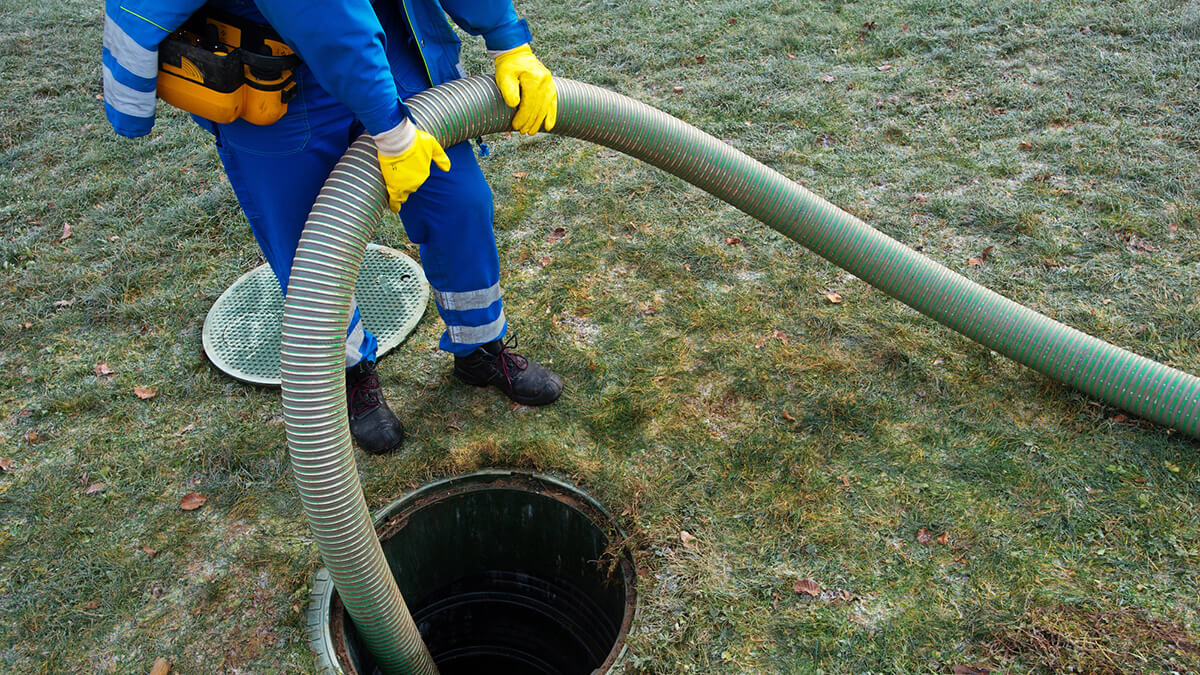More than 60 million people in the U.S. use septic systems, particularly in rural and suburban areas. Although, homes with septic tanks typically have a different selling process than a home connected to a public sewer system.
In this article, we’ll cover all you need to know about selling a property with a septic system, including maintenance requirements, inspection protocols, and potential challenges. We’ll also discuss how to navigate the process smoothly, whether you’re selling on the open market or considering a cash offer.
Whether you have a septic system or public sewer system, iBuyer.com can guarantee a seamless transaction. We can provide cash offers without the stress of repairs and inspections.
Selling a House With a Septic Tank
- What Is a Septic System?
- What Kind of Maintenance Is Required to Keep a Septic System in Good Condition?
- Selling a Property With a Septic Tank: Is It Required to Get It Inspected?
- What Is Involved in a Septic System Inspection?
- Is a House Marketed Differently If It Has a Septic System?
- What Can Cause a Septic System to Fail?
- Selling a House With Septic Tank Problems
- Are You Ready to Sell Your House?
Compare Cash Offers from Top Home Buyers. Delivered by Your Local iBuyer Certified Specialist.
One Expert, Multiple Offers, No Obligation.
What Is a Septic System?
Septic systems are wastewater treatment structures that are installed underground. Using a combination of proven technology and nature to treat your household’s wastewater, they typically consist of a drain field and a septic tank.
You might hear septic systems referred to by a number of different names, including:
- Individual sewage disposal systems
- Private sewage systems
- Decentralized wastewater treatment systems
- Cluster system
- Package plants
- On lot systems
- On-site wastewater treatment systems
Septic systems are not connected to a centralized or public sewer system. For this reason, they’re common in rural areas.
What Kind of Maintenance Is Required to Keep a Septic System in Good Condition?
The wastewater that comes from our laundry, kitchen, and bathroom has to be treated to neutralize or remove pollutants and pathogens. These include things like nitrogen and phosphorus.
In public sewer systems, wastewater flows into pipes that get progressively larger until they arrive at a wastewater treatment plant. When you have a septic system, this treatment is happening right on your property.
Commonly, septic systems have a septic tank, a drain field, and the main drainage pipe. Drain fields are also referred to as soil absorption fields. There might also be additional components such as electrical float switches and pumps.
The septic tank itself is often made out of polyethylene, fiberglass, or concrete. It is a watertight container that is buried underneath the ground. In the tank, liquid wastewater is separated from organic matter, solids, and floatable material.
The liquid wastewater then moves onto the drain field. From there, it disperses through the soil. The solids and other material that is left in the septic tank will stay there until you have a professional septic service pump your tank.
It typically takes between one to two days for solids to settle in a septic tank. However, the settling time decreases as the tank fills up.
When a septic tank reaches more than one-third of the liquid depth, it’s time for the tank to be pumped.
If the drain field is overloaded or the tank is overdue for drainage, problems can occur. This can cause sewage to flow into the ground, cause flooding, or cause sewage to backflow into the home.
It’s a good idea to have your home’s septic tank and system inspected every three years. You’ll also want to have it pumped every three to five years. How often you need to do it will depend on a number of factors, including the size of the tank and the size of your household.
Are you wondering if you should sell your house now? Check out this article to learn whether or not the time is right for you.
Selling a Property With a Septic Tank: Is It Required to Get It Inspected?
If you are listing the home on the open market, you’ll want to talk to a real estate agent about what is required in your state. Increasingly, mortgage companies have been wanting septic tank inspections so they can know whether or not there’s a potential issue with it.
An inspection might not be necessary, though, if a seller can show that the tank has been serviced and pumped recently.
A home inspector also might request a septic system inspection if they notice that there are some signs of issues. This includes things like backflow in the drains or slow-flowing toilets.
What Is Involved in a Septic System Inspection?
You can hire a qualified private contractor to inspect your septic system. In some places, the local health department also might provide this service for a fee.
Usually, an inspection will involve finding the underground tank’s location. This might mean using a sketch of the property and system that was made during the permitting process. Or it can mean flushing a small radio transmitter down the toilet, which is then removed once they locate the tank.
The inspector will then use a long, hollow pole that is known as a Sludge Judge to measure the level of solids in the tank. They will also check the other components in the tank.
A number of factors will determine how much this inspection costs. They usually cost between $100 and $250. It could cost more than this, though, depending on your location, how deep the tank is, and whether or not an inspector has to uncover it.
It’s important to understand that the cost of having a septic tank inspected is quite small compared to the potential cost of paying for repairs. To replace a drain field, for example, can cost you anywhere between $2,500 and $10,000.
Is a House Marketed Differently If It Has a Septic System?
People who are looking to purchase rural property are often aware of the fact that they usually have septic systems. However, it can be good to let buyers know if part of the septic tank has been updated or replaced.
What Can Cause a Septic System to Fail?
If your septic system is having problems, you’ll want to hire a plumber that specializes in septic. They’ll be able to determine what needs to be done to your system. Let’s take a look at some of the common causes of septic tank issues.
You Neglected to Maintain the System
As mentioned earlier, your septic system should be pumped and inspected every 3 to 5 years. You might be able to just do a deep clean of your septic tank to help reverse the failure of the system. However, if you grossly neglected the system, this likely won’t work as a solution.
The System Was Damaged By Outdoor Landscaping or Tree Roots
Outdoor landscaping in the wrong place or tree roots looking for nutrients and moisture can damage your system. Roots can grow nearby or into the system and damage or cross components. This can happen directly or indirectly, with roots sometimes compacting the soil and damaging pipes or preventing proper discharge.
It can also be problematic to install a car park or a paved driveway too close to a drain field.
You might be able to repair the system rather than replace it, depending on what was damaged. It typically costs around $1,500 to replace a damaged or crushed pipe.
The Tank Wasn’t Installed Correctly
There is little you can do if your tank was installed incorrectly to keep it from failing. It’s possible that it’s not watertight, in a bad location, or it’s the wrong size.
If you have to replace the drain field to help prevent failure, it means digging up the entire system and replacing it. This can cost anywhere between $2,000 and $10,000 depending on the location of the system and its size. This only works, though, if the tank can be repurposed.
If you have to install a whole new system, it can cost between $8,000 and $25,000. Repairing a system typically costs, at most, $10,000.
Too Much Water Is Entering the System at Once
Your home septic tank was designed to manage a certain amount of water based on how big the home is. If you use more water than the capacity of the tank, it can overwhelm the system. This can mean that wastewater backs up into the drains, pipes, or the home.
To fix this, you’ll want to pump and clean the system. You might have to replace the full system, though, if it’s simply too small for your home.
Are you wondering how to sell a property if it’s distressed? Click here to learn more.
Selling a House With Septic Tank Problems
If you want to sell your home and you know the septic system has issues or has failed completely, you have a few different options.
Selling a House on the Open Market
First, you’ll want to look into what the laws are in your area. In some places, it’s illegal to sell a home with a septic system that isn’t up to code. This can vary between counties as well as states.
If you live in a place where the septic system must be up to code to sell it, then you’ll have to fix it before the sale.
If you go the route of replacing the septic system, you’ll want to get an estimate of the cost. How much it costs will depend on the cost of permitting in your area as well as the size of the system. On average, you can expect to pay:
- Between $600 and $3,000 for the tank
- $1,000 or less for the permitting
- Between $3,000 and $9,500 for the new system installation
- Between $1,200 and $4,500 for land prep and excavation
You also might consider whether or not there is a sewer line that you can hook your house up to that has been installed since your house was built. This requires that you decommission your septic tank and new plumbing lines are installed on your property. There also might be connection fees and permitting fees that your municipality or city charges.
It can cost anywhere between $1200 and $4800 to connect your house to the public system. The associated fees can cost anywhere between $500 and $20,000 depending on your location.
Selling a House As-Is
If the cost of fixing or replacing your septic system made you gasp, there is another option.
You might consider selling your house as-is. When you go this route, you are selling to a cash buyer who isn’t relying on financing from a lender.
Investors will be familiar with whether or not a house with a failed septic system can be legally purchased as an investment property in your area. Also, if your septic system only has problems, but hasn’t completely failed, an investor might still be interested in the property.
When you sell a house as-is, you don’t have to make repairs before selling. Instead, the buyer is planning on making the repairs in order to sell the house for a profit or rent out the property.
If you find the house selling process stressful, as many people do, you will be relieved to know that selling a house as-is is a much more hassle-free process. It can happen faster and in a much more seamless way, allowing you to get on with your life without the constant headaches of selling a house.
Are You Ready to Sell Your House?
If the idea of dealing with all of the hassles of selling a house makes you start to feel a bit ill, there is a quick and easy way you can sell your home. Selling a property with a septic tank doesn’t have to be too much complicated than selling a more traditional house, but if there are any issues with the septic system it can start to get messy fast.
When you sell to a trusted iBuyer, you don’t have to make any repairs, deal with any showings, or participate in the long-drawn-out process of a buyer receiving financing.
Are you wondering how much your house could sell for? Click here to get your free home value today!
Instant Valuation, Confidential Deals with a Certified iBuyer.com Specialist.
Sell Smart, Sell Fast, Get Sold. No Obligations.
Reilly Dzurick is a seasoned real estate agent at Get Land Florida, bringing over six years of industry experience to the vibrant Vero Beach market. She is known for her deep understanding of local real estate trends and her dedication to helping clients find their dream properties. Reilly’s journey in real estate is complemented by her academic background in Public Relations, Advertising, and Applied Communication from the University of North Florida.




